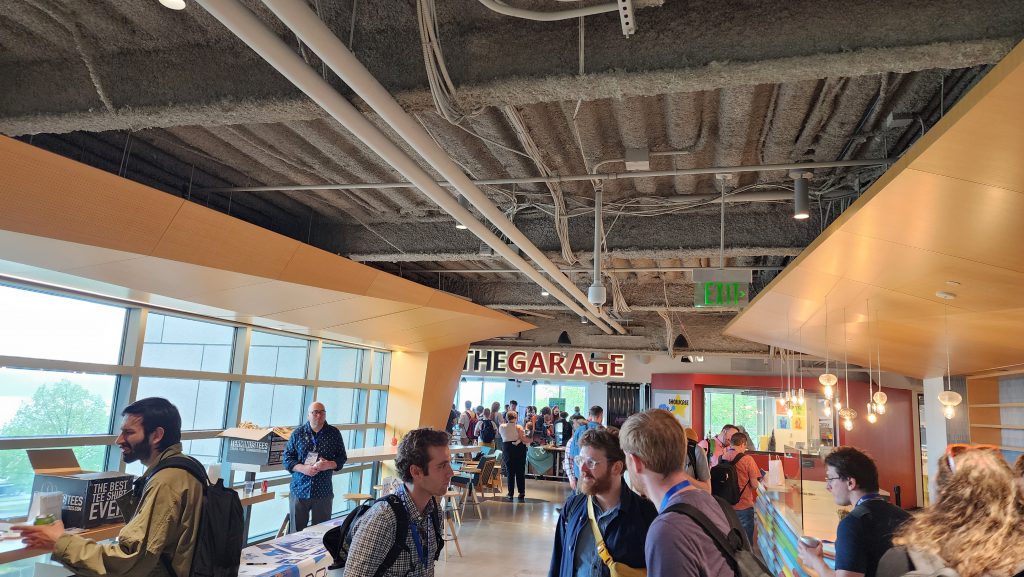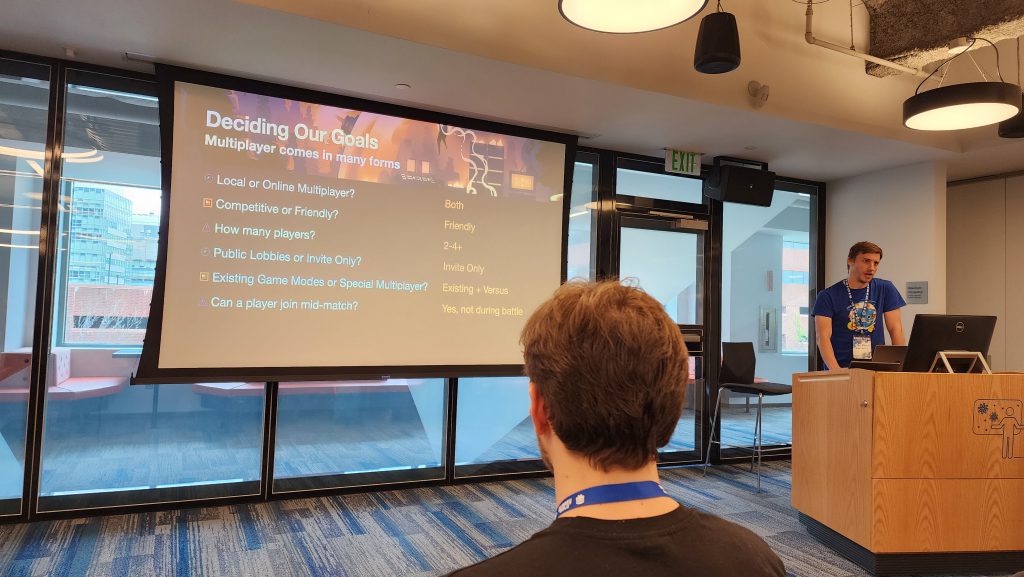In May of 2025, I took a break from working on my game, Dice Tower, and flew out to Boston, Massachussetts to attend GodotCon. It’s a convention centered around the game engine I work with, Godot; it was the first time the event was held in the United States of America, my home country. GodotCon was amazing, and I want to share my experience!
Yes, this is the same Dice Tower that I said a few years ago we were going to finish quickly. That’s a story for another day.
Arrival in Boston – Sunday
I flew into Boston on Sunday morning, which gave me a bit of time to explore the city before GodotCon started on Monday. This is a city steeped in American history, and I felt that as I explored the downtown area. I took a duck boat tour of the city, and got to hear more about Boston’s history. I also spent some time in the New England Aquarium, which has a unique 250,000 gallon aquarium pillar and an open-air penguin exhibit I found fascinating.
I walked to Neptune Oyster Bar for supper. As a Minnesotan, I rarely get a chance to experience fresh seafood, and Neptune served some amazing oysters and lobster roll. Afterwards, I meandered my way back to the car and drove to my hotel, ready to call it a night and rest up for three days of GodotCon.

GodotCon Day 1 – Monday
On Monday, I drove to the Microsoft N.E.R.D. campus, where GodotCon was being hosted. After checking in and getting my badge, I made my way to the GodotCon floor and spent the day chatting with fellow Godot devs and attending two workshops:
Building a Godot Plugin with GDExtension
I’ve never worked with GDExtension before, so this was my first opportunity to try it out. Its ability to take any language (in this case, C++, which I also got a first-time experience with) and bind it as a Godot API is incredibly powerful, and this is something I’d love to tinker around with more in the future.
Narrative Design for Solo Devs
I’ve not had many chances yet to design narrative-driven games, so this was a chance for me to create something using narrative concepts and a Godot/Inkle integration called inkgd. My output won’t win any awards, for sure, but it was nice to finally flex my narrative muscles in a project!
Afterwards, we hung out at a nearby bar, where I spent hours more talking with fellow convention goers, as well as members of the Boston Gamedev scene (whose group was largely responsible for bringing GodotCon to America). Many great conversations were had, and I didn’t head back to the hotel until late at night.

GodotCon Day 2 – Tuesday
Tuesday opened with a keynote by Emi Coppola, executive director of the Godot Foundation. From there, I spent the morning playing various Godot games at the showcase, and the afternoon attending presentations.
The games I played:
- Neongarten, a roguelike city builder (developed by a fellow Josh!)
- Dunderbeck, a backpack autobattler with meaty lore
- Dante’s 9, a roguelite platformer where abilities are drawn as a hand of cards
- Memori, a Celeste-inspired Platformer
- Burrito Bear, an arcade came about a bear eating falling burritos
The talks I attended:
Making Operation Outbreak … into a Godot game
Andres Colubri told the story of how Operation Outbreak, an in-person game designed to model viral spread in outbreaks, was made into a Godot game. The story was fascinating, and the impetus for this project is a cool example of using games for study and research.
What’s new in XR & Android (2025)
David Snopek, Fredia Huya-Kouadio, and Logan Lang presented an official update on the progress made with Godot for XR (which is virtual reality and augmented reality combined in one term) and on the Android platform. I’m not familiar with this side of Godot, so it was great to dip my toes in those waters.
Scratching the itch.io – Godot Game Distribution Strategies
Danny Silvers talked about Itch.io, one of the more well-known games distribution platforms outside of Steam, and why it’s beneficial and simple for devs to have a presence there. His points got me thinking about doing this for Dice Tower; in particular, I learned that people who buy games on Itch.io can be more loyal, since they have reason to go to Itch.io instead of Steam.
Improving Your UI in Godot
Rawb Herb built a pause menu in Godot, sharing UI and design insights along the way. I enjoyed seeing his takes, and plan to reference the notes I took as I continue developing Dice Tower’s UI.

GodotCon Day 3 – Wednesday
Wednesday was mostly spent attending talks and chatting with people in between.
The talks I attended:
LibGodot – Embed Godot Engine Everywhere
This was about Migeran‘s efforts developing LibGodot and using it to embed the Godot engine into multiple different programs, leveraging the GDExtension API introduced in Godot 4; targets include Unreal, TypeScript, and Java. It was eye-opening to see this kind of tech; while I don’t yet have a need to embed Godot in other places, it’s now something in the back of my mind for, perhaps, some future effort.
I Work for Godot, AMA
Emi, David Snopek, and Adam Scott answered questions around their work, encompassing a good cross-section of Godot work from the Godot Foundation to W4 Games (the company started by Godot veterans to provide enterprise-focused services). One thing that stuck with me is how their biggest problems relate to scale—with the drastic increase in Godot users over the last few years, there is far more work to do than volunteers to do it, making prioritization critical to moving Godot forward.
Two other speakers were to be part of the AMA, but, due to current tensions with U.S. immigration, they were unable to attend. Sadly, this perfectly valid concern was brought up more than once during conversations, and it saddens me that my country made this an issue.
Keeper to Keepers: Adding Multiplayer to Dome Keeper
Dome Keeper is one of Godot’s more well-known success stories (and one of my favorite games), and Chris Ridenour of KAR Games talked about how his company took that single-player game and worked to convert it to work with multiplayer. I’ve never designed or built a multiplayer game, so this overview was a great talk for getting my feet wet and having that info in mind for the future.
The YouTube Crash Course for Game Devs
StayAtHomeDev is well-known for bringing exposure to Godot projects through his YouTube channel, and this talk was both a primer for how one can get going with a YouTube channel and a call of encouragement for us to create, whether our games or YouTube videos or otherwise. As the previous talk’s speaker was unable to make it, StayAtHomeDev also answered some questions beforehand about various topics. I’ve always had a YouTube channel in the back of my mind, and this talk was a nudge towards potentially acting on those thoughts.
I chatted with StayAtHomeDev multiple times during the conference. He’s an awesome guy, and we even share a common background in web development!
Enjoyable Game Architecture with Godot & C#
Mark Wilson gave a talk around flexible architecture and how the Chickensoft ecosystem leverages clean architecture principles to make enjoyable tools and paradigms working with Godot and C#. I don’t work with C# (yet), but I’ve known Chickensoft’s founder for years, so I’ve been part of their community. After the talk, we got a group photo of the Chickensoft folks who made it to GodotCon!
Lightning Talks
The final talk of the day was seven microtalks across a variety of topics. They all gave me interesting things to think about, from how to produce faster with a game jam mentality to improving time management to using custom resources to manage global state. It was a great set of closing talks.
After the Con, I left to hang out with an old friend living in the Boston area, and then flew back to Minnesota on Thursday.

Aftermath
Throughout GodotCon, I found myself inspired to be with so many people who use Godot. I’m usually in a minority in that regard when attending gamedev gatherings, so it was awesome to talk Godot and other topics with fellow Godot devs. Likewise, it was awesome to see a wide variety of Godot projects and see what others have done within the game engine I love working with.
I talked with a lot of people, both at GodotCon itself and at surrounding events (I even offered a couple people a ride home one day, and got some great discussion out of it). Everyone was kind, friendly, and passionate about their projects and their love for Godot. I’ve heard so many awesome stories and backgrounds, hopes and dreams, ideas and ideals, corridor chats and bar banter. It felt amazing to be a part of.
In addition to meeting new people, I had a fun few encounters with people I knew from elsewhere:
- Adam, a guitarist for the band Steel Samurai, which just performed at VGM Con, where I was showing Dice Tower. (I caught the second half of that concert, it was great!)
- David Snopek, a W4 employee and Godot maintainer whom I met at MDEV last year.
- Daniel Johnsen, who showed off a Godot game (Golfella!) alongside Dice Tower at 2D Con in 2023.
- One of the members of the Nice Games Club community, a gamedev podcast local to my home metropolis.
Finally, throughout GodotCon, I talked to people about Dice Tower and showed them videos of the game’s gameplay. The response to Dice Tower was universally positive, giving me great encouragement.
All in all, I thoroughly enjoyed GodotCon and the city of Boston. I’d love to do it again next year!
The talks will be posted to Godot’s YouTube channel in the near future; be sure to check those out!

